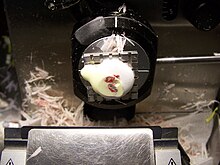
The frozen section procedure is a pathological laboratory procedure to perform rapid microscopic analysis of a specimen. It is used most often in oncological surgery.[1] The technical name for this procedure is cryosection. The microtome device that cold cuts thin blocks of frozen tissue is called a cryotome.[2]
The quality of the slides produced by frozen section is of lower quality than formalin fixed paraffin embedded tissue processing. While diagnosis can be rendered in many cases, fixed tissue processing is preferred in many conditions for more accurate diagnosis.
The intraoperative consultation is the name given to the whole intervention by the pathologist, which includes not only frozen section but also gross evaluation of the specimen, examination of cytology preparations taken on the specimen (e.g. touch imprints), and aliquoting of the specimen for special studies (e.g. molecular pathology techniques, flow cytometry). The report given by the pathologist is often limited to a "benign" or "malignant" diagnosis, and communicated to the surgeon operating via intercom. When operating on a previously confirmed malignancy, the main purpose of the pathologist is to inform the surgeon if the resection margin is clear of residual cancer, or if residual cancer is present at the resection margin. The method of processing is usually done with the bread loafing technique. But margin controlled surgery (CCPDMA) can be performed using a variety of tissue cutting and mounting methods, including Mohs surgery.
- ^ "Testing Biopsy and Cytology Specimens for Cancer" (PDF).
- ^ "Cryotome". TheFreeDictionary.com. Retrieved 3 November 2021.